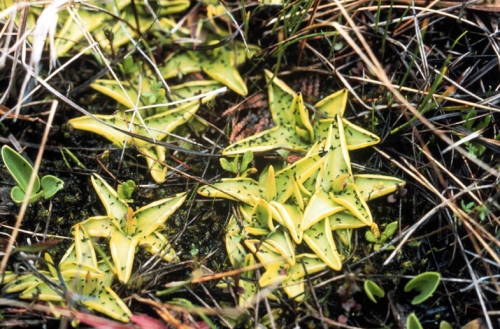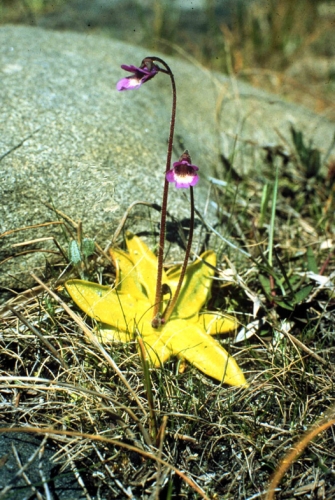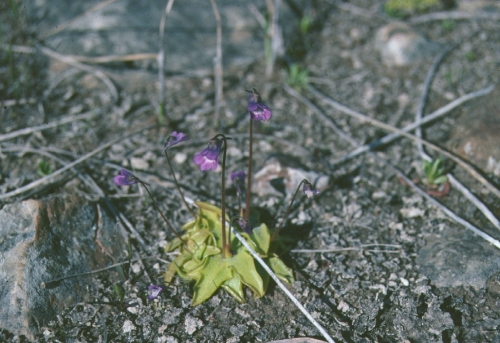Plants and Animals
Pinguicula vulgaris Butterwort
Key Characteristics
Small forb of northern fens and calcareous rocky shorelines; leaves distinctively yellow and forming a basal rosette; flower blue-violet borne singly on a tall stalk (10 cm).
Status and Rank
US Status: No Status/Not Listed
State Status: SC - Special Concern (rare or uncertain; not legally protected)
Global Rank: G5 - Secure
State Rank: S3 - Vulnerable
Occurrences
| County | Number of Occurrences | Year Last Observed |
|---|---|---|
| Alger | 11 | 2022 |
| Alpena | 2 | 1981 |
| Charlevoix | 4 | 2023 |
| Chippewa | 3 | 2018 |
| Delta | 2 | 1990 |
| Emmet | 4 | 2018 |
| Houghton | 1 | 1994 |
| Keweenaw | 24 | 2018 |
| Mackinac | 20 | 2024 |
| Marquette | 1 | 2016 |
| Presque Isle | 3 | 2010 |
Information is summarized from MNFI's database of rare species and community occurrences. Data may not reflect true distribution since much of the state has not been thoroughly surveyed.
Habitat
Butterwort is found in wet depressions within dunes along Great Lakes shorelines, along cobbly-marly shores and marly fens (especially in eastern Upper Peninsula), as well as on alkaline bedrock (conglomerate and basalt) shores of western Upper Peninsula.
Natural Community Types
- Alvar
- Coastal fen
- Interdunal wetland
- Limestone bedrock lakeshore
- Limestone cobble shore
- Northern fen
- Sand and gravel beach
- Sandstone lakeshore cliff
- Volcanic bedrock lakeshore
- Volcanic lakeshore cliff
- Wooded dune and swale complex
For each species, lists of natural communities were derived from review of the nearly 6,500 element occurrences in the MNFI database, in addition to herbarium label data for some taxa. In most cases, at least one specimen record exists for each listed natural community. For certain taxa, especially poorly collected or extirpated species of prairie and savanna habitats, natural community lists were derived from inferences from collection sites and habitat preferences in immediately adjacent states (particularly Indiana and Illinois). Natural communities are not listed for those species documented only from altered or ruderal habitats in Michigan, especially for taxa that occur in a variety of habitats outside of the state.
Natural communities are not listed in order of frequency of occurrence, but are rather derived from the full set of natural communities, organized by Ecological Group. In many cases, the general habitat descriptions should provide greater clarity and direction to the surveyor. In future versions of the Rare Species Explorer, we hope to incorporate natural community fidelity ranks for each taxon.
Associated Plants
Arkansas mint, Houghton's goldenrod, hardstem and softstem bulrush, sundew, Ohio goldenrod, Kalm's lobelia, and spikemoss (Selaginella eclipes).
Management Recommendations
Butterwort is vulnerable to foot traffic and ORVs. Where it occurs in wetlands, protection of hydrology is also important.
Survey Methods
Random meander search covers areas that appear likely to have rare taxa, based on habitat and the judgment of the investigator.
-
Meander search
-
Survey Period: From first week of June to fourth week of August
-
References
Survey References
- Elzinga, C.L., D.W. Salzer, and J.W. Willoughby. 1998. Measuring and Monitoring Plant Populations. The Nature Conservancy and Bureau of Land Management, Denver. BLM Technical Reference 1730-1. 477pp.
- Goff, G.F., G.A. Dawson, and J.J. Rochow. 1982. Site examination for Threatened and Endangered plant species. Environmental Management 6(4): 307-316
- Nelson, J.R. 1984. Rare Plant Field Survey Guidelines. In: J.P. Smith and R. York. Inventory of rare and endangered vascular plants of California. 3rd Ed. California Native Plant Society, Berkeley. 174pp.
- Nelson, J.R. 1986. Rare Plant Surveys: Techniques For Impact Assessment. Natural Areas Journal 5(3):18-30.
- Nelson, J.R. 1987. Rare Plant Surveys: Techniques for Impact Assessment. In: Conservation and management of rare and endangered plants. Ed. T.S. Elias. California Native Plant Society, Sacramento. 8pp.
Technical References
- Coffin, B. and L. Pfannmuller, eds. 1988. Minnesota's Endangered Flora and Fauna. University of Minnesota Press, Minneapolis. 473pp.
- Crow, G.E. and C.B. Hellquist. 2000. Aquatic and Wetland Plants of Northeastern North America. Volume 1. Pteridophytes, Gymnosperms, and Angiosperms: Dicotyledons. University of Wisconsin Press, Madison. 480pp.
- Gleason, H. A., and A. Cronquist. 1991. Manual of Vascular Plants of Northeastern United States and Adjacent Canada. 2nd Ed. The New York Botanical Garden, New York, New York.
- Gray, A. 1950. Gray's Manual of Botany; eighth ed. Van Nostrand Reinghold, New York. 1632pp.
- Holmgren, N.H. 1998. Illustrated Companion to Gleason and Cronquist's Manual. Illustrations of the vascular plants of Northeastern United States and adjacent Canada. New York Botanical Garden, Bronx. 937pp.
- Scoggan, H.J. 1978. The Flora of Canada. National Museum of Natural Science Publications Botany 4: 1711pp.
- Voss, E.G. 1996. Michigan Flora. Part III. Dicots (Pyrolaceae-Compositae). Bulletin of the Cranbrook Institute of Science and University of Michigan Herbarium. 622pp.




